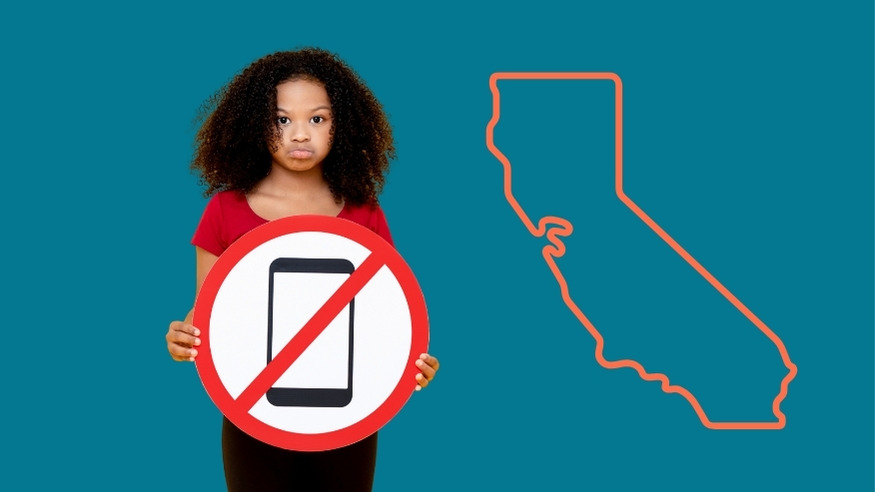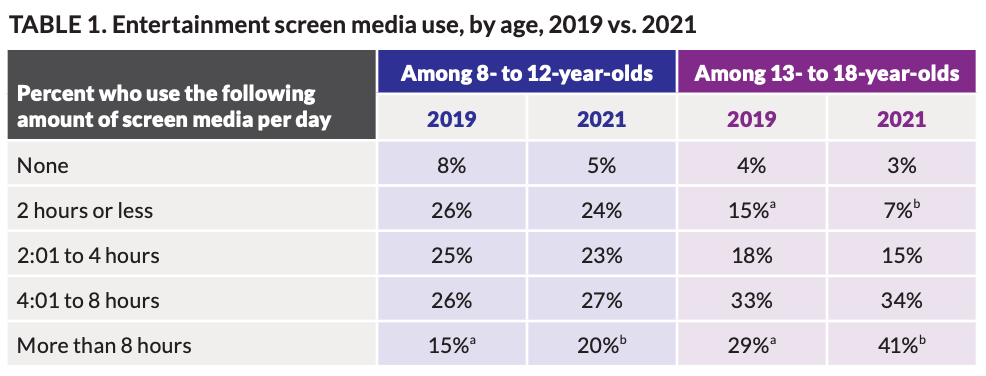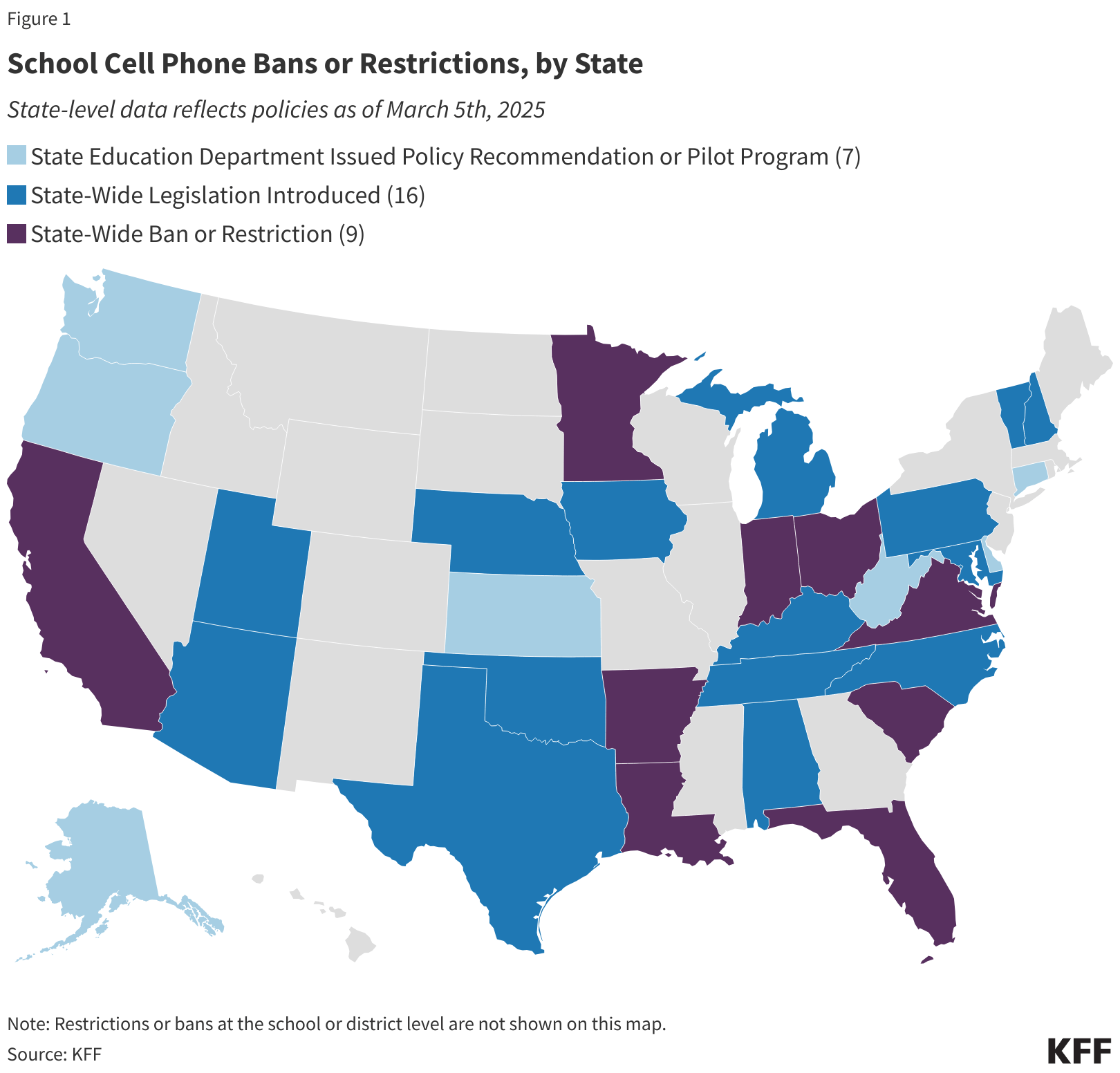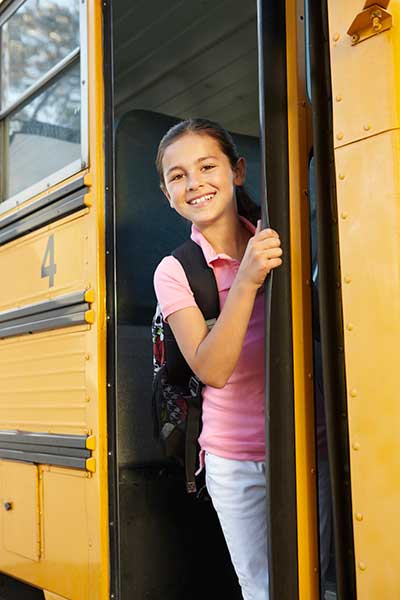Is your school ready to ban smartphones?

California law restricts phone use in schools
The question is no longer whether your school should limit smartphone use in schools — it’s now the law. The question now is how.
The California Phone-Free School Act requires every school district, charter school, and county office of education to adopt a policy limiting or prohibiting the use of smartphones. It’s not optional. By July 1, 2026, your school needs a clear plan that everyone understands and will accept.
The problem
There is growing evidence that unlimited smartphone use is bad for us — and especially bad for kids and teens. California legislators passed the Phone-Free School law with urgency and near-unanimity because the proliferation of phones in schools “lowers pupil performance, promotes cyberbullying, and contributes to an increase in teenage anxiety, depression, and suicide.”
Smartphones have been widely identified as a primary culprit in a range of bad outcomes. For example, colleges report that since the introduction of smartphones, large numbers of students are unprepared for college-level reading.
Excessive screen time: 8 hours per day!
Screen media use by students is excessive. (Yes, that’s a mother speaking.) It has grown dramatically since the pandemic.
Surveys by Common Sense Media reveal the rapid and alarming growth in teens' screen time. More than forty percent of teens spend in excess of 8 hours a day on screens. Yes, this means many kids are spending more time on screen-based entertainment than they spend on sleep! The rates are rising.

Surgeon General warning!
This level of obsession and distraction is unhealthy for anyone, but it's especially bad for kids. In a formal report released in May, 2023, the United States Surgeon General focused especially on the risk of harm that social media inflicts on the mental health and well-being of children and adolescents. This warning is a big deal.
Not one to mince words, Surgeon General Dr. Vivek H. Murthy has called for warning labels on social media platforms. “The mental health crisis among young people is an emergency — and social media has emerged as an important contributor.” He also advised that “schools should ensure that classroom learning and social time are phone-free experiences.”
The more time spent on social media, the higher the risk of self-harm, depression, and lower levels of self-esteem. If you want to dig deeper, the National Library of Medicine has extensive research you can read (when you are not scrolling.)
Measuring the harm of smartphones in schools
Smartphone use in schools is bad for students. A summary report, The Status and Evidence for School Cell Phone Bans, helps count some of the ways:
- Distraction: 75% of high school teachers report that cell phones are a major distraction in the classroom (2018 Pew Research Poll).
- Attention: Students without phones during class write down more information during class.
- Performance: Students who reported being distracted by other students using digital devices scored 15 points lower in PISA tests than those who barely experienced this (PISA 2022)
- Cheating: 30% of students use cell phones to cheat in the classroom (likely an underestimate).
- Loneliness: The presence of cell phones has been linked to increased rates of loneliness within schools; youth reporting loneliness are more likely to drop out of school at the age of 16.”
States scramble to ban cell phones in schools
With the harms so clear, nations and US states are moving quickly to take policy action, at least in schools. KFF.org, a San Francisco-based nonprofit organization focused on health policy, has taken a leading role in gathering state-by-state information about rapidly-changing smartphone policies in schools and their impact. The map below is a snapshot from KFF as of March 5, 2025. (Click it to check KFF for updated data.)

What’s the next step?
Under California law, parents and communities must be involved in the development of smartphone school policies. How do we start?
Luckily, the US Department of Education created a Playbook in 2024 to help communities develop policies. The biggest question to begin with is to decide whether restrictions will be schedule-based or full-day:
Schedule-based: Student device use is prohibited at certain times during the school day (e.g., during instruction) while permitting limited use at other times, such as during breaks or lunch period.
Full-day: Student device use is prohibited during the school day, including during instructional time, lunch or free periods, and passing times.
The table below provides guidance about other major questions that your school needs to grapple with:
| Considerations for smartphone policies | |
|---|---|
Safety |
Is there a school emergency operations plan in place that details how parents and caregivers will receive communications in the event of an emergency? Has the plan been tested to ensure its effectiveness in the event of an emergency? Are there clear expectations for personal device use during a school emergency? Note: Consider using the Department’s K-12 School and District Emergency Management Planning Tools. |
Exceptions |
California law allows students to use a phone in an emergency, with permission, for the health or well-being of the pupil, and when a smartphone is required in a pupil’s individualized education program. Read Designing Policies with Students with Diverse Needs (See page 21 of the Playbook). |
Storage |
Are there circumstances when a device might be taken away from a student, and if so, where is it stored? What is the return policy? How will students store devices off and away during instruction (e.g., in over-the-door organizers, baskets, bookbags)? Will a consistent storage solution be used in all classrooms, or will educators decide which storage solution to implement? How will students store devices away for the day (e.g., in pouches, lockers, bookbags)? Note: Consider the cost implications and who assumes the primary burden for enforcement. (e.g., teachers, school leaders) based on each storage solution. |
Cost |
What is the cost to equip each classroom with an off and away storage solution (e.g., over-the-door organizer)? If using pouches, what is the cost to purchase or lease pouches each school year? Is this cost sustainable? Who is responsible for the replacement cost of a pouch that is lost or damaged (e.g., school, student)? |
Enforcement |
Who is responsible for enforcement? Are roles and responsibilities of staff clearly articulated within current responsibilities? Note: Different staff including school leaders, school security personnel, front office staff, or teachers may play different roles. For example, who checks and seals pouches, collects phones, enforces consequences. |
Training |
What training do educators and staff need to implement the personal device policy consistently and effectively? |
Responsible use |
Have we clearly outlined our expectations for how students will responsibly use their personal devices and school-issued devices? (See sample Responsible Use Policy.) What are the expectations for obtaining permission from staff or other students before taking photos or videos? |
Communication |
How do we communicate the policy to students, families, educators, and staff to ensure everyone understands the expectations, requirements, and consequences outlined in the policy? |
Evaluation |
How and at what intervals will we gather data and insights about our personal device policy to ensure it is meeting our goals? What feedback loops can we establish with students, families, educators, and staff to understand what is working and where adjustments may be needed to address emerging issues, changes in technology, or evolving educational priorities? |
Parents and teachers: Here’s where you come in.
It's time to check with your school district to find out how it is developing a policy. This must involve students, parents, and educators in your community.
Ask your school district to ensure there is appropriate outreach to teachers, students, and parents and that opportunities are provided for review of the proposal.
Essential to the success of a school smartphone policy is that parents also implement policies at home. The American Academy of Pediatrics offers advice on how parents can work with their children on Setting Limitations on Tech Time.
Tags on this post
Student motivation Mental HealthAll Tags
A-G requirements Absences Accountability Accreditation Achievement gap Administrators After school Algebra API Arts Assessment At-risk students Attendance Beacon links Bilingual education Bonds Brain Brown Act Budgets Bullying Burbank Business Career Carol Dweck Categorical funds Catholic schools Certification CHAMP Change Character Education Chart Charter schools Civics Class size CMOs Collective bargaining College Common core Community schools Contest Continuous Improvement Cost of education Counselors Creativity Crossword CSBA CTA Dashboard Data Dialogue District boundaries Districts Diversity Drawing DREAM Act Dyslexia EACH Early childhood Economic growth EdPrezi EdSource EdTech Education foundations Effort Election English learners Equity ESSA Ethnic studies Ethnic studies Evaluation rubric Expanded Learning Facilities Fake News Federal Federal policy Funding Gifted Graduation rates Grit Health Help Wanted History Home schools Homeless students Homework Hours of opportunity Humanities Independence Day Indignation Infrastructure Initiatives International Jargon Khan Academy Kindergarten LCAP LCFF Leaderboard Leadership Learning Litigation Lobbyists Local control Local funding Local governance Lottery Magnet schools Map Math Media Mental Health Mindfulness Mindset Myth Myths NAEP National comparisons NCLB Nutrition Pandemic Parcel taxes Parent Engagement Parent Leader Guide Parents peanut butter Pedagogy Pensions personalized Philanthropy PISA Planning Policy Politics population Poverty Preschool Prezi Private schools Prize Project-based learning Prop 13 Prop 98 Property taxes PTA Purpose of education puzzle Quality Race Rating Schools Reading Recruiting teachers Reform Religious education Religious schools Research Retaining teachers Rigor School board School choice School Climate School Closures Science Serrano vs Priest Sex Ed Site Map Sleep Social-emotional learning Song Special ed Spending SPSA Standards Strike STRS Student motivation Student voice Success Suicide Summer Superintendent Suspensions Talent Teacher pay Teacher shortage Teachers Technology Technology in education Template Test scores Tests Time in school Time on task Trump Undocumented Unions Universal education Vaccination Values Vaping Video Volunteering Volunteers Vote Vouchers Winners Year in ReviewSharing is caring!
Password Reset
Search all lesson and blog content here.
Login with Email
We will send your Login Link to your email
address. Click on the link and you will be
logged into Ed100. No more passwords to
remember!














Questions & Comments
To comment or reply, please sign in .